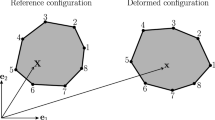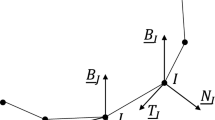Abstract
In this paper, a polygonal finite element method is presented for crack growth simulation with minimum remeshing. A local polygonal mesh strategy is performed employing polygonal finite element method to model the crack propagation. In order to model the singular crack tip fields, the convex and concave polygonal elements are modified based on the singular quarter point isoparametric concept that improves the accuracy of the stress intensity factors. Numerical simulations are performed to demonstrate the efficiency of various polygonal shape functions, including the Wachspress, metric, Laplace and mean value shape functions, in modeling the crack tip fields. Eventually, analogy of the results with the existing numerical and experimental data is carried out depicting accuracy of the propounded technique.




































Similar content being viewed by others
References
Baker AJ (2012) Finite elements: computational engineering sciences. Wiley, New Jersey
Barsoum RS (1976) On the use of isoparametric finite elements in linear fracture mechanics. Int J Numer Meth Eng 10:25–37
Belytschko T, Black T (1999) Elastic crack growth in finite elements with minimal remeshing. Int J Numer Meth Eng 45:601–620
Belytschko T, Krongauz Y, Organ D, Fleming M, Krysl P (1996) Meshless methods: an overview and recent developments. Comp Meth Appl Mech Eng 139:3–47
Biabanaki SOR, Khoei AR (2012) A polygonal finite element method for modeling arbitrary interfaces in large deformation problems. Comput Mech 50:19–33
Biabanaki SOR, Khoei AR, Wriggers P (2014) Polygonal finite element methods for contact-impact problems on non-conformal meshes. Comp Meth Appl Mech Eng 269:198–221
Bouchard PO, Bay F, Chastel Y (2003) Numerical modelling of crack propagation: automatic remeshing and comparison of different criteria. Comp Meth Appl Mech Eng 192:3887–3908
Bouchard PO, Bay F, Chastel Y, Tovena I (2000) Crack propagation modeling using an advanced remeshing. Comp Meth Appl Mech Eng 189:723–742
Bui HD (1983) Associated path independent J-integral for separating mixed modes. J Mech Phys Solids 31:439–448
Chan SK, Tuba IS, Wilson WK (1970) On the finite element method in linear fracture mechanics. Eng Fract Mech 2:1–17
Chi H, Talischi C, Lopez-Pamies O, Paulino GH (2015) Polygonal finite elements for finite elasticity. Int J Numer Meth Eng 101:305–328
Erdogan F, Sih GC (1963) On the crack extension in plates under plane loading and transverse shear. J Basic Eng 85:519–525
Floater MS (2003) Mean value coordinates. Comp Aided Geo Des 20:19–27
Floater MS, Hormann K, Kos G (2006) A general construction of barycentric coordinates over convex polygons. Adv Comput Math 24:311–331
Gain AL, Talischi C, Paulino GH (2014) On the virtual element method for three-dimensional linear elasticity problems on arbitrary polyhedral meshes. Comp Meth Appl Mech Eng 282:132–160
Griffith AA (1921) The phenomena of rupture and flow in solids. Philos Trans R Soc Lond A 221:163–198
Henshell RD, Shaw KG (1975) Crack tip finite elements are unnecessary. Int J Numer Meth Eng 9:495–507
Hormann K (2004) Barycentric coordinates for arbitrary polygons in the plane. Technical Report, Clausthal University of Technology, Germany
Huang R, Sukumar N, Prevost JH (2003) Modeling quasi-static crack growth with the extended finite element method, part II: numerical applications. Int J Solids Struct 40:7539– 7552
Hussain M, Pu S, Underwood J (1974) Strain energy release rate for a crack under combined mode I and mode II. ASTM STP 560:2–28
Ingraffea AR (2004) Computational fracture mechanics. In: Stein E, De Borst R, Hughes TJR (eds) Encyclopedia of computational mechanics, vol 2. Wiley, New Jersey
Ingraffea AR, Grigoriu M (1990) Probabilistic fracture mechanics: a validaition of predictive capability. Technical Report, Cornell University, New York
Khoei AR (2015) Extended finite element method, theory and applications. Wiley, New Jersey
Khoei AR, Azadi H, Moslemi H (2008) Modeling of crack propagation via an automatic adaptive mesh refinement based on modified superconvergent patch recovery technique. Eng Fract Mech 75:2921–2945
Khoei AR, Eghbalian M, Moslemi H, Azadi H (2013) Crack growth modeling via 3D automatic adaptive mesh refinement based on modified-SPR technique. Appl Math Model 37:357–383
Khoei AR, Moslemi H, Ardakany KM, Barani OR, Azadi H (2009) Modeling of cohesive crack growth using an adaptive mesh refinement via the modified-SPR technique. Int J Fract 159:21–41
Khoei AR, Yasbolaghi R, Biabanaki SOR (2015) A polygonal-FEM technique in modeling large sliding contact on non-conformal meshes; a study on polygonal shape functions. Eng Comput 32:1391–1431
Leon SE, Spring DW, Paulino GH (2014) Reduction in mesh bias for dynamic fracture using adaptive splitting of polygonal finite elements. Int J Numer Meth Eng 100:555–576
Li FZ, Shih CF, Needleman A (1985) A Comparison of methods for calculating energy release rates. Eng Fract Mech 21:405–421
Malsch EA, Dasgupta G (2004a) Interpolations for temperature distributions: a method for all non-concave polygons. Int J Solids Struct 41:2165–2188
Malsch EA, Dasgupta G (2004b) Shape functions for polygonal domains with interior nodes. Int J Numer Meth Eng 61:1153–1172
Malsch EA, Lin JJ, Dasgupta G (2005) Smooth two-dimensional interpolations: a recipe for all polygons. J Graph 10:27–39
Manzini G, Russo A, Sukumar N (2014) New perspectives on polygonal and polyhedral finite element methods. Math Mod Meth Appl Sci 24:1665–1699
Meyer M, Barr A, Lee H, Desbrun M (2002) Generalized barycentric coordinates on irregular polygons. J Graph Tools 7:13–22
Mildbradt P, Pick T (2008) Polytope finite element. Int J Numer Meth Eng 73:1811–1835
Moslemi H, Khoei AR (2009) 3D adaptive finite element modeling of non-planar curved crack growth using the weighted superconvergent patch recovery method. Eng Fract Mech 76:1703–1728
Mousavi SE, Xiao H, Sukumar N (2010) Generalized Gaussian quadrature rules on arbitrary polygons. Int J Numer Meth Eng 82:99–113
Natarajan S, Bordas S, Roy Mahapatra D (2009) Numerical integration over arbitrary polygonal domains based on Schwarz–Christoffel conformal mapping. Int J Numer Meth Eng 80:103–134
Ooi ET, Song C, Tin-Loi F, Yang Z (2012a) Automatic modelling of cohesive crack propagation in concrete using polygon scaled boundary finite elements. Eng Fract Mech 93:13–33
Ooi ET, Song C, Tin-Loi F, Yang Z (2012b) Polygon scaled boundary finite elements for crack propagation modelling. Int J Numer Meth Eng 91:319–342
Pinkall U, Polthier K (1993) Computing discrete minimal surfaces and their conjugates. Exper Math 2:15–36
Rand A, Gillete A, Bajaj C (2014) Quadratic serendipity finite elements on polygons using generalized barycentric coordinates. Math Comput 83:2691–2716
Rashid MM (1998) The arbitrary local mesh replacement method: An alternative to remeshing for crack propagation analysis. Comp Meth Appl Mech Eng 154:133–150
Rice JR (1968) A path independent integral and the approximate analysis of strain concentrations by notches and cracks. J Appl Mech 35:379–386
Sih G (1974) Strain–energy–density factor applied to mixed mode crack problems. Int J Fract 10:305–321
Spring DW, Leon SE, Paulino GH (2014) Unstructured polygonal meshes with adaptive refinement for the numerical simulation of dynamic cohesive fracture. Int J Fract 189:33–57
Sukumar N (2004) Construction of polygonal interpolants: a maximum entropy approach. Int J Numer Meth Eng 61:2159–2181
Sukumar N (2013) Quadratic maximum-entropy serendipity shape functions for arbitrary planar polygons. Comp Meth Appl Mech Eng 263:27–41
Sukumar N, Malsch EA (2006) Recent advances in the construction of polygonal finite element interpolants. Arch Comput Meth Eng 13:129–163
Sukumar N, Moran B, Semenov AY, Belikov VV (2001) Natural neighbour Galerkin methods. Int J Numer Meth Eng 50:1–27
Sukumar N, Tabarraei A (2004) Conforming polygonal finite elements. Int J Numer Meth Eng 61:2045–2066
Tabarraei A, Sukumar N (2005) Adaptive computations on conforming quadtree meshes. Finite Elem Anal Des 41:686–702
Tabarraei A, Sukumar N (2006) Application of polygonal finite elements in linear elasticity. Int J Comput Meth 3:503–520
Talischi C, Paulino GH (2014) Addressing integration error for polygonal finite elements through polynomial projections: a patch test connection. Math Mod Meth Appl Sci 24:1701–1727
Talischi C, Pereira A, Paulino GH, Menezes IFM, Carvalho MS (2014) Polygonal finite elements for incompressible fluid flow. Int J Numer Meth Fluids 74:134–151
Wachspress EL (1975) A rational finite element basis. Academic Press, New York
Warren J (1996) Barycentric coordinates for convex polytopes. Adv Comput Math 6:97–108
Warren J, Schaefer S, Hirani AN, Desbrun M (2007) Barycentric coordinates for convex sets. Adv Comput Math 27:319–338
Acknowledgments
The authors are grateful for the research support of the Iran National Science Foundation (INSF).
Author information
Authors and Affiliations
Corresponding author
Rights and permissions
About this article
Cite this article
Khoei, A.R., Yasbolaghi, R. & Biabanaki, S.O.R. A polygonal finite element method for modeling crack propagation with minimum remeshing. Int J Fract 194, 123–148 (2015). https://doi.org/10.1007/s10704-015-0044-z
Received:
Accepted:
Published:
Issue Date:
DOI: https://doi.org/10.1007/s10704-015-0044-z




